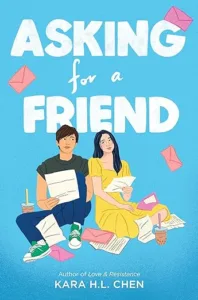Asking for a Friend
Kara H. L. Chen
Quill Tree Books
Published July 23, 2024
Amazon | Bookshop | Goodreads
About Asking for a Friend
This charming YA rom-com follows a strong-willed, ambitious teen as she teams up with her childhood frenemy to start a dating-advice column, perfect for fans of Emma Lord and Gloria Chao.
Juliana Zhao is absolutely certain of a few things:
1. She is the world’s foremost expert on love.
2. She is going to win the nationally renowned Asian Americans in Business Competition.
When Juliana is unceremoniously dropped by her partner and she’s forced to pair with her nonconformist and annoying frenemy, Garrett Tsai, everything seems less clear. Their joint dating advice column must be good enough to win and secure bragging rights within her small Taiwanese American community, where her family’s reputation has been in the pits since her older sister was disowned a few years prior. Juliana always thought prestige mattered above all else. But as she argues with Garrett over how to best solve everyone else’s love problems and faces failure for the first time, she starts to see fractures in this privileged, sheltered worldview. With the competition heating up, Juliana must reckon with the sacrifices she’s made to be a perfect daughter—and whether winning is something she even wants anymore.
My Review
There’s nothing like reading a great rom-com when you need an escape from the world. Reading this book cheered me up quite a bit. It does wrestle with some big issues as Juliana grapples with the pressure to win the AABC competition, which is her father’s legacy. Her mom expects her to partner with the boy she thinks is the smartest and hardest working, but when he drops Juliana as a partner, she has to improvise a new plan.
It took me a long time to realize that Juliana and Garrett had a history. I think it was vaguely alluded to when she decides to work with him, but I assumed they went to school together or knew each other from community events. I didn’t realize there was more to it until much later in the book.
The conflict between Juliana’s older sister and her mom is really sad, especially since they’ve already lost her dad. The book does a great job contextualizing Juliana and her mom’s choices. I never felt like I didn’t understand why they did what they did, even if I wished they did something different.
The slow-burn romance kept me reading and, when I wasn’t reading, thinking about the story. Garrett is a great character, and I love the way he encourages Juliana without trying to control her.
All in all, this is a fun, light romance. Readers who enjoyed Clementine and Danny Save the World (and Each Other) by Livia Blackburne or The Charmed List by Julie Abe will like this one.
Content Notes
Recommended for Ages 12 up.
Representation
Juliana and many other characters are Taiwanese Americans.
Profanity/Crude Language Content
About a half-dozen instances of profanity in the book.
Romance/Sexual Content
Kissing between boy and girl. Juliana’s older sister got pregnant unexpectedly while in college and dropped out.
Spiritual Content
None.
Violent Content
Juliana’s mom disowned her sister after finding out about her pregnancy. Juliana’s dad passed away from cancer a few years before the story begins.
Drug Content
None.
Note: This post contains affiliate links, which do not cost you anything to use but help support this blog. I received a free copy of this book in exchange for my honest review. All opinions are my own.
